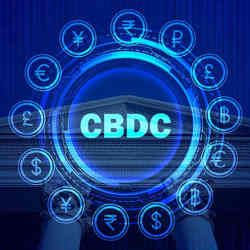
Central banks across the world are embarking on a brave new experiment. They are exploring central bank digital currencies (CBDCs), a digital form of government-backed, government-controlled money.
CBDCs are purely digital currencies. Unlike cryptocurrencies like Bitcoin, CBDCs are tied to a nation's currency and are centrally regulated. They take the best of cryptos—speed, universal transfers and transactions—and put those benefits under the authority of a national government. As a result, CBDCs are a smarter version of cash that enables central banks to deal directly with institutions (banks, etc.), rather than relying on today's legacy payment and transfer infrastructure to move money. CBDCs also enable smarter banking for individual citizens, in theory opening up a future where citizens could transact directly with central banks.
Not every CBDC project is alike. Some CBDCs use blockchain, the technology which underpins cryptocurrencies, while others are simply exclusively digital forms of national currencies.
More than 80 central banks globally have started to explore CBDCs in an effort to make markets and payments work better. The highest-profile exploratory work today comes from the U.S., which is toying with the idea of a "digital dollar." However, only 14% of central banks have actually launched a CBDC pilot program or have one in development.
Among those actually using CBDCs, China's "digital yuan" is the most notable. China has already given away millions in digital yuan to its citizens. The CBDC can be used for payment at JD.com, one of the country's biggest ecommerce companies, and citizens can turn digital yuan into cash, if needed, at more than 3,000 ATMs across China.
CBDCs are generating plenty of controversy and debate.
The Society for Worldwide Interbank Financial Telecommunication (SWIFT) network enables financial institutions worldwide to send and receive financial data in a secure, standardized environment, but it is slow, costly, and inefficient. As a result, it can take days or weeks to settle large monetary transfers. CBDCs sidestep the SWIFT network completely, transacting directly with institutional players.
Some worry that CBDCs have fatal flaws. Central banks already manipulate monetary policy; CBDCs could give them the ability to tweak the rules of how a currency works overnight, by giving them direct control over a CBDC's blockchain or digital infrastructure. They also could erode privacy, with every transaction and payment clearly visible to governments.
But that's not slowing down their development.
"I think that within three to five years, we will see over a dozen retail CBDCs in both emerging and industrialized countries," says Co-Pierre Georg, an associate professor at South Africa's University of Cape Town and an expert on CBDCs.
CBDCs make sense because of their utility, says Georg. Today, most CBDC projects are wholesale CBDCs that aim to provide a better transfer and payment system for large-value interbank payments. CBDCs can make interbank markets, foreign exchange transactions, and derivatives markets faster and more efficient, he says, because they eliminate the third-party infrastructure that settles transactions between central banks and market players. Blockchain-based CBDCs also can eliminate counterparty risk by logging transactions on the blockchain, which removes the need for a bank or regulatory agency to verify transactions.
At some point, CBDCs could bring these benefits to payments made by individual citizens as well. The European Central Bank and U.S. Federal Reserve are evaluating retail CBDCs that would function as "smart cash" by giving citizens the ability to transact with digital currency directly issued by a central bank.
"If the Federal Reserve competed with banks and fintechs for payment processing, it would help drive down the often ridiculously high fees people pay for digital transactions," says Bill Maurer, director of the Institute for Money, Technology, and Financial Inclusion at the University of California, Irvine. He reasons that more competition in the space will curtail costs.
Yet it's not all upside; there is significant skepticism about CBDCs.
The American Bankers Association (ABA), a banking lobby group, is critical of CBDCs as a replacement for today's banking system. The ABA pointed to a statement the organization gave to a Congressional subcommittee in which it said CBDCs are "not feasible because of the increased costs and operational burdens placed on central banks." Because CBDCs would be issued and managed by a central bank, that would make a central bank the direct provider of banking services to consumers, says the ABA. The corresponding operational burden would be immense; today, U.S. retail banks have over two million employees to accomplish the same goal.
This kind of centralization could also be dangerous, says Georg. "Whoever operates the [CBDC] ledger can always access and overwrite it, eroding not just privacy, but trust in the payment instrument itself."
CBDCs also may not adequately serve society's most vulnerable populations. Cash is a lifeline for unbanked or underbanked populations that don't have access to high-tech solutions. "There is a great deal of concern around inclusiveness and whether the less-privileged would be able to access CBDCs," says Etay Katz, a senior partner in the financial regulation practice at U.K.-based law firm Ashurst.
Not every country will develop or adopt CBDCs, says Stephen McKeon, a finance professor at the University of Oregon with expertise in cryptocurrency assets.
"One [way forward] is to develop a nationally sanctioned digital currency," McKeon says. "Another is to designate an existing digital currency, such as Bitcoin, as legal tender."
Logan Kugler is a freelance technology writer based in Tampa, FL, USA. He has written for over 60 major publications.



Join the Discussion (0)
Become a Member or Sign In to Post a Comment